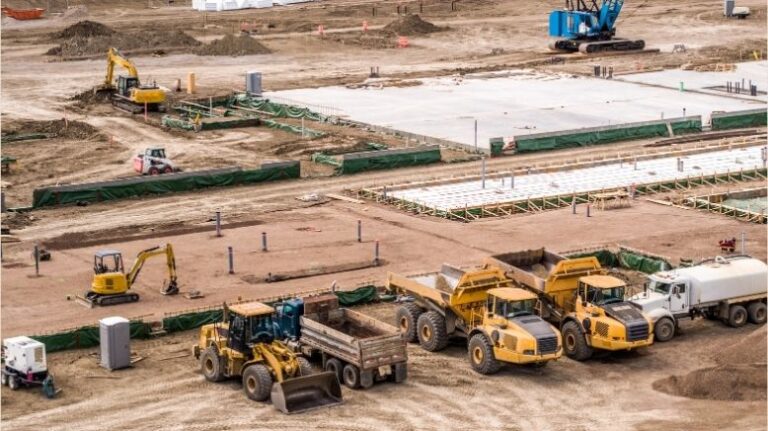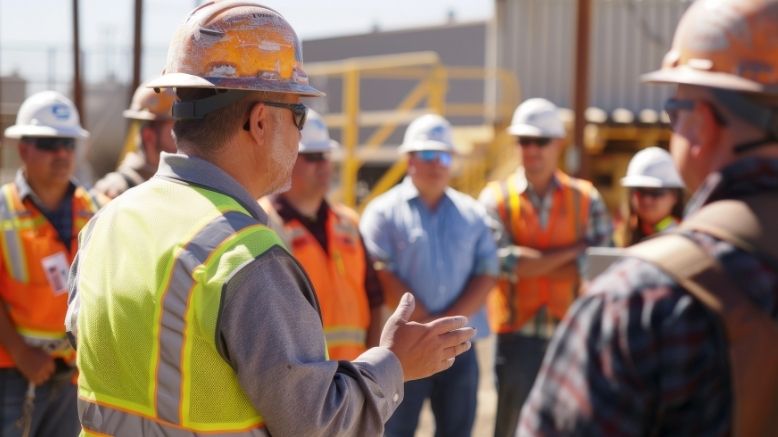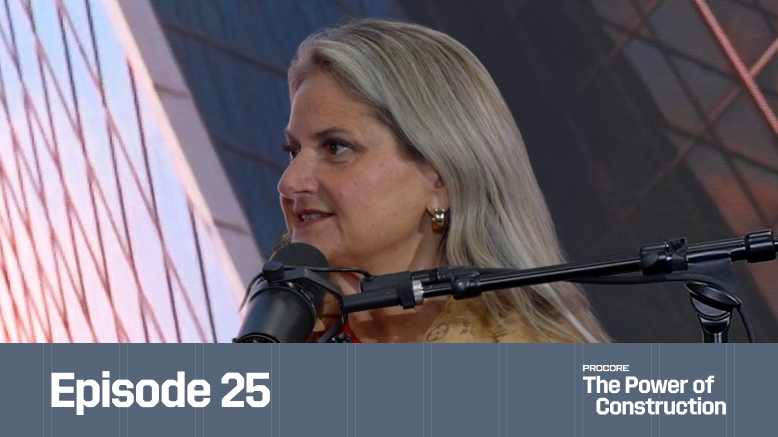— 7 min read
Construction Fleet Management: How to Keep Construction Companies Moving

Last Updated Sep 19, 2025

Tamara Aspeling
Writer & Construction Estimator
10 articles
Tamara Aspeling is a trained construction estimator and project manager with 25 years of industry experience. She started writing professionally in 2008 and has since written extensively for the construction industry, including publications like Modular Advantage magazine. She is also a traditionally published nonfiction author and the owner of The Construction Writer Inc. Tamara studied at Western Province Technical College in South Africa and completed her national certificate in 1999. She also holds an SEO Certification from Google and a Content Marketing Certification from HubSpot.
Last Updated Sep 19, 2025

In most industries, fleet management typically involves managing company cars or a fleet of semis. Construction fleet management is a very different animal, simply because construction companies have a much broader range of vehicles and equipment to manage.
Let's take a look at how construction fleet management factors into onsite plans, systems and processes.
Table of contents
What is a construction fleet?
In construction, a fleet can include dump trucks, excavators, bulldozers, telehandlers, graders and many other kinds of equipment. The scope may also include cars, trucks, semis and motorcycles.
A construction equipment fleet might also include vehicles that don’t have engines, like various kinds of trailers. Many of the machines that make up construction equipment fleets also work considerably harder than most other corporate fleets.
What is construction fleet management?
Because construction companies have such a vast array of vehicles and equipment types, plans and processes to manage them are usually more complex. Fleet management is a business function that monitors and manages both the equipment and processes. There are also usually stricter regulations governing those vehicles and equipment, and they are often directly involved in productivity and profitability.
Construction fleet management is a complex and multifaceted business process that extends across the full lifecycle of any vehicle or piece of equipment.
Below are some key things a construction fleet management plan include.
Sourcing and Purchasing Vehicles and Equipment
Construction fleet management begins with selecting the right vehicles or equipment, negotiating the best possible deal and determining the most beneficial financing options.
Many construction companies sell off vehicles and equipment when they reach predetermined mileage, so they can avoid wear-and-tear-related costs, and this could also be an ongoing and frequent process.
Applying Company Branding to Vehicles
Whether it’s a full vinyl graphic wrap, a spray job in company colors or just decals on the doors, most construction fleet vehicles and equipment will need to be branded before they are deployed in the field — and this is part of the fleet management process.
Enrolling in and Managing Tracking Systems
Most commercial construction fleets will have some kind of tracking systems that monitor location, speed, idling, fuel usage and more. These systems are an integral part of the fleet management function, including the initial enrollment and hardware outfitting of vehicles and equipment.
Daily Checks
Every fleet management plan should include daily driver checklists. These act as an early warning system and ensure that appropriate action is taken as soon as necessary. Construction fleet managers should also collect and analyze all daily reports to maintain a paper trail and to drive proactive decision-making.
Routine Maintenance and Servicing
Construction vehicles and equipment can take quite a beating. Routine and preventative maintenance and servicing are one of the most important things companies can do to extend the lifespan of those vehicles.
Repairs
Even with proper preventative and routine maintenance, construction vehicles do still sometimes need repairs for damage or due to wear and tear.
This falls under construction fleet management, along with making sure that vehicles that are out of commission during those repairs are replaced as necessary to maintain production goals.
Planning, Deployment & Idle Time Tracking
Having the right vehicles and equipment is only one part of an effective construction fleet management plan.
Those vehicles also have to be tracked, deployed to the right job sites at the right times and moved to other sites when they are no longer required. This helps to limit idle time, particularly for construction equipment, which is a big silent cost for many construction companies.
Fuel Monitoring & Management
From tracking direct fuel expenses to keeping control of fuel usage, monitoring fuel usage is a critical part of construction fleet management.
Controlling emissions usually also falls under this part of the plan, and may include things like using the right kind of additives, depending on the fuel in question.
Driver Management, Training & Safety Protocols
Vehicles are a big part of fleet management, but they’re usually only as good and safe as the people behind the wheel.
The driver management part of a construction fleet management plan should include everything from driver training to ensuring they comply with all regulations, including those that deal with how long they can be on the road!
Compliance
Because construction vehicles and equipment work on many different sites, managing health and safety, environmental and site-specific compliance can be a tricky process.
Construction fleet management teams should have day-to-day plans in place to ensure baseline compliance with all regulations, but also create site-specific plans to ensure all specific contractual requirements are met for all job sites.
Cost Control & Planning
Construction vehicles and equipment are expensive to purchase, run, insure, repair, maintain and sometimes even dispose of. Cost control and planning include everything from budgeting to reports.
Benefits of Construction Fleet Management
The benefits of good construction fleet management go far beyond cost, time and convenience. It’s a necessary part of operating a successful construction business.
Saves Money
Efficient fleet management reduces operational costs.
Keeps Things Moving
A good fleet management plan allows for smooth and timely delivery of materials and services. Having all the necessary equipment available, safe and functional onsite can help prevent production delays — and the lost costs associated with them.
Enhances Safety
Proper fleet management can prevent safety incidents onsite. Proper equipment maintenance and regular checks minimize environmental hazards.
Mitigates Legal Risk
Proper training, compliance with safety standards and adherence to driving hours all reduce accident risks. With fewer accidents, there are fewer possible legal disputes — and in the case of an accident, proper adherence to regulatory standards can prevent court cases.
The benefits of good construction fleet management go far beyond cost, time and convenience. It’s a necessary part of operating a successful construction business.
Using Construction Fleet Management Tools
The good news for construction businesses that are struggling with fleet management — or firms that are expanding their fleet or looking to improve existing systems — is that there are several tools and platforms that can help.
Construction equipment management tools can alert fleet managers when there is excessive idle time, so they can redeploy equipment for maximum effectiveness.
Modern GPS tracking tools for vehicles not only track the location of each vehicle, but can also alert fleet managers when individual units exceed the speed limit, when drivers are approaching their safe driving time limit or when vehicles are idling more than they should be.
Developing and Implementing Construction Fleet Management Plans
Since construction fleet management is about so much more than just assigning vehicles and tracking fuel-related expenses, construction companies that are planning to implement or improve a construction fleet management plan should spend some extra time on the process.
During the process, it’s a good idea to incorporate several departments and focus areas, such as:
- Finance, estimating and project management teams to review budgets, provide historical cost data and highlight possible cost savings or productivity improvements
- Health and safety representatives and officers who can provide insight into the most up-to-date legislation, regulations and reporting requirements
- Field and from vehicle operators to provide insight and feedback on what’s working and areas that need improvement
- Environmental and contract specialists to address specific compliance and other requirements
A good construction fleet management plan is not about a single department operating in isolation, but about collaboration between many different business entities to develop the best and most efficient plan and processes.
It’s also wise to plan regular follow-up and review meetings, so that all stakeholders can provide updated information as necessary, and processes can be adjusted accordingly.
The True Value of Construction Fleet Management
Construction fleet management is about so much more than keeping vehicles on the road: The vehicles any company uses are an important resource, and like any resource, when they aren’t available and ready to use on demand, production rates and schedules can be detrimentally affected.
Delays and idle time are two of the easiest ways to increase project costs and reduce profits, so it’s essential that construction companies develop comprehensive, end-to-end fleet management plans as early as possible and review them frequently.
Whenever possible, use technology to streamline and improve processes. Modern fleet management tools can cut the time and cost required to manage a construction vehicle fleet, provide greater control and enable collaboration across different job sites, business locations and departments.
Like everything else, your construction fleet management plan does not have to be perfect on day one. It can and should evolve and change as your business needs do.
Was this article helpful?
Thank you for your submission.
0%
0%
You voted that this article was . Was this a mistake? If so, change your vote
Scroll less, learn more about construction.
Subscribe to The Blueprint, Procore’s construction newsletter, to get content from industry experts delivered straight to your inbox.
By clicking this button, you agree to our Privacy Notice and Terms of Service.
Thank you!
You’re signed up to receive The Blueprint newsletter from Procore. You can unsubscribe at any time.
Categories:
Written by

Tamara Aspeling
Writer & Construction Estimator
10 articles
Tamara Aspeling is a trained construction estimator and project manager with 25 years of industry experience. She started writing professionally in 2008 and has since written extensively for the construction industry, including publications like Modular Advantage magazine. She is also a traditionally published nonfiction author and the owner of The Construction Writer Inc. Tamara studied at Western Province Technical College in South Africa and completed her national certificate in 1999. She also holds an SEO Certification from Google and a Content Marketing Certification from HubSpot.
View profileExplore more helpful resources

Defending Against Financial & Legal Risks on Megaprojects
The construction industry has seen marked growth in megaprojects. Some experts classify any project over $500 million as a megaproject, while others argue that the build needs to be $1...

Unlocking Project Intelligence: Moving from Raw Data to Actionable Insights
The construction industry faces a wide range of challenges, from ongoing labor shortages to frequent cost overruns. But some the biggest hurdles all stem from unpredictability. The general contractors (GCs)...

Who is accountable for innovation in construction?
Everyone says construction needs to innovate—but no one agrees on who’s actually responsible for making it happen. Is it the owner? The builders? The tech vendor? Or is innovation everyone’s...

Integrated Project Delivery in Practice: A Framework for Collaboration
On construction projects, traditional delivery methods put different stakeholders in their own silos. While the design team feeds drawings and specifications to the general contractor (GC), the GC’s expertise in...
Free Tools
Calculators
Use our calculators to estimate the cost of construction materials for your next project.
Templates
Find a template to help you with your construction project tasks.
Material Price Tracker
Get the latest U.S. retail prices and view historical trends for common building materials.
Glossary
Explore key terms and phrases used in the industry.
